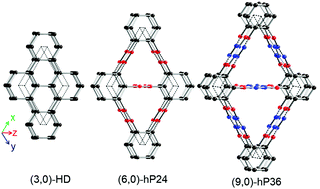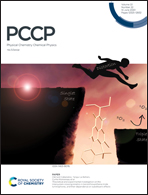New carbon allotropes derived from nanotubes via a three-fold distortion mechanism†
Abstract
Besides commonly used graphite, carbon nanotubes are also often chosen as precursor materials for the synthesis of new carbon phases. Here we identify, using ab initio calculations, two new three-dimensional crystalline modifications of carbon nanotubes with P63/mcm (D36h) symmetry derived from (6,0) and (9,0) nanotubes via a three-fold distortion assisted reconstruction mechanism. The resulting sp2 + sp3 hybrid network structures have a 24- and 36-atom hexagonal unit cell, termed as (6,0)-hP24 and (9,0)-hP36 carbon, and they topologically correspond to two-dimensional graphyne and graphdiyne. Total-energy calculations show that they are energetically more stable than the original nanotubes and previously reported polymerized nanotube structures. Their dynamic stability has been confirmed by phonon mode analysis. Electronic band structure calculations reveal that they are semiconductors with an indirect band gap of 0.18 eV for hP24, and a direct band gap of 2.15 eV for hP36. The present results establish a new type of carbon phase and offer insights into understanding the complex structural landscape of polymerized nanotubes.



 Please wait while we load your content...
Please wait while we load your content...